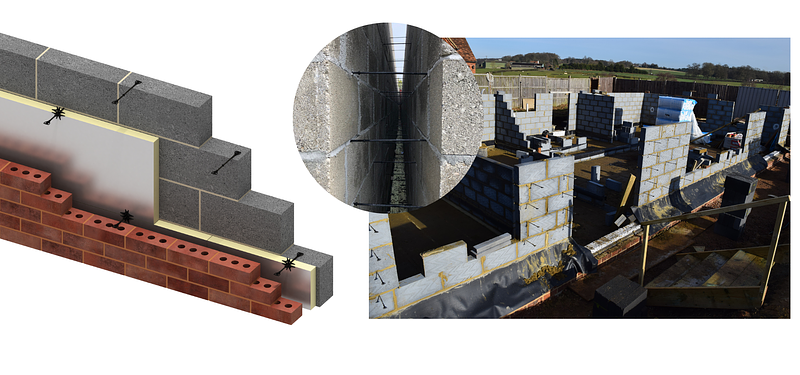Specifying Wall Ties for Energy Efficient Cavity Walls

With the UK construction sector preparing for the implementation of the Future Homes Standard in 2025, the design of the building envelope will be critical in the delivery of energy efficient housing. Thermally efficient cavity wall construction and the correct specification and installation of wall ties will help housebuilders meet updated Part L Regulations and achieve the U-value and fabric requirements in the Future Homes Standard.
Part L Regulations and the fabric-first approach has led to wider cavities, enabling specifiers to incorporate thicker insulation and significantly improve thermal performance. However, the wider the cavity, the greater the importance of specifying and installing the correct wall ties. Playing a crucial role in restraining two leaves of a cavity wall together, wall tie specification can be overlooked but this has implications for structural integrity, thermal performance and regulatory compliance.

Wider cavity requirements
The first consideration for any cavity wall is the correct tie length. Wall ties must span the cavity and embed at least 50mm into each leaf of the wall. Ancon wall ties use a design embedment of 62.5mm, which provides a cavity range for each length of tie and allows for some site tolerance. For wider cavities, the tie length must increase accordingly to achieve this embedment whilst maintaining structural performance and compliance with PD6697:2019. For example, the Ancon Staifix HRT4 300mm wall tie is designed specifically for wider cavity walls between 151mm and 175mm, which aligns with modern insulation requirements and wider wall designs.
Correct specification of wall tie type classification is also essential. In the UK, wall ties are classified as Type 1, 2, 3, or 4 according to PD 6697:2019. Building height, structure and location need to be taken into account when determining the tie type required. For domestic buildings up to 10 metres in height, Type 4 ties such as Ancon Staifix HRT4 meet the PD6697 standard for light-duty applications. It’s also important to ensure the tie is approved for use in party walls in accordance with Building Regulations Part E as acoustic-rated ties are essential when sound insulation is a priority.
Minimising thermal bridging
In wider cavities, thermal bridging can increase. Metal ties can create a path for heat to travel through the insulation layer, compromising the U-value of a wall. Therefore, specifying low thermal conductivity ties (e.g. stainless steel or basalt fibre ties) helps reduce heat loss across the cavity. The Ancon Teplo-BF Wall Tie is manufactured from protruded basalt fibres and has a thermal conductivity of only 0.7W/mK.
The thermal efficiency of this innovative material means these ties are excluded from U-value calculations under BS EN ISO 6946. Furthermore, when insulation is compressed or displaced by the wall tie this can also lead to thermal bridging. Wall ties must therefore be installed carefully and be appropriately spaced to avoid disruption to the insulation layer.
.png)
Moisture management
Moisture management is critical in cavity wall construction. Drip features are built into modern wall ties to prevent water crossing the cavity and reaching the inner leaf. The Ancon Staifix HRT4 range includes a multi-drip feature designed to direct moisture away from the structure. Proper installation is essential: ties should be installed level and horizontal or with a slight fall towards the outer leaf, and the drip should be located centrally in the cavity.
Wider cavities can help reduce moisture transfer, but only when the wall ties used are installed correctly and are resistant to corrosion. Stainless steel ties offer excellent long-term performance, even in wet conditions, making them ideal for cavity walls with increased exposure.
Best practice on site
Despite their simplicity, wall tie installation errors are not uncommon on site. One of the most frequent mistakes is using ties of the wrong length. Wall ties that are too short will not provide the necessary embedment and can compromise structural performance, especially under high wind loads. Conversely, excessively long ties may bow or flex under load and can be more thermally conductive, increasing the risk of cold bridging.
Incorrect spacing is another common issue. PD6697:2019 recommends a minimum of 2.5 ties per square metre, with maximum horizontal spacing 900mm and vertical spacing not exceeding 450mm. Additional ties should be installed around openings and at unreturned or unbonded edges.
Other installation errors include bending wall ties on site, allowing mortar droppings to build up on ties, or installing ties with the drip in the wrong orientation. Each of these can lead to reduced performance, either by undermining moisture resistance, thermal integrity, or structural connection.
At a time when the housebuilding sector is under increasing pressure to futureproof housing to meet stricter thermal requirements, cavity widths will increase which means that wall ties must no longer be treated as an afterthought. Structural performance, thermal efficiency, moisture management and acoustic compliance all rely on the correct specification and installation of wall ties. By getting this small detail right, housebuilders can play their part in ensuring the long-term durability, performance and compliance with the evolving demands of residential construction.
Download Wall Ties Installation Guide (PDF, 344 KB)
To learn here: https://www.ancon.co.uk/products/wall-ties-restraint-fixings/cavity-wall-ties
Alternatively contact us on sales.ancon.uk@leviat.com or call +44 (0) 114 275 5224


0 comments
Please leave a comment using the form below